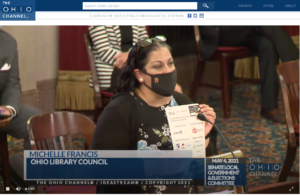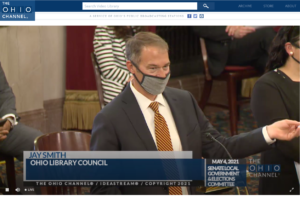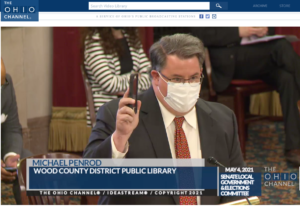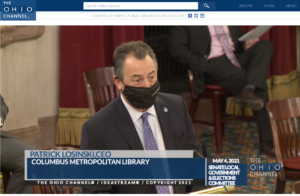OLC Testifies on State Budget Bill Before Ohio Senate Local Government and Elections Committee

OLC’s Executive Director Michelle Francis explains how Ohio’s public libraries quickly pivoted to digital services during the pandemic to meet the needs of their communities.
Today, the OLC testified on Substitute House Bill (HB) 110, the biennial state budget bill, in front of the Ohio Senate Local Government and Elections Committee. OLC’s Executive Director Michelle Francis told lawmakers how public libraries were able to quickly pivot and adjust their service delivery models to continue to meet the needs of their local communities during the pandemic.
“Public library services are essential to the communities we serve. This was already evident pre-pandemic and became even more profound over the past year,” Francis said. “Our members will always have books on the shelves, but our services today go far beyond books. We meet patrons where they are – if they are at home, at school or outside one of our buildings.”
Francis provided specific examples of what libraries did when the pandemic started and what they continue to do today, such as loaning Plexiglas to small businesses, offering curbside pick up service, and engaging families with virtual storytimes. She also explained how Ohio’s public libraries increased digital services and expanded internet access to keep Ohioans connected during the pandemic.
“As we come out of the pandemic, Ohio’s public libraries will be here to work with our schools to address the pandemic educational gaps we are seeing in Pre-K and Kindergarten as well as minority populations and economically disadvantaged communities,” Francis said. “We will be here to assist in workforce development efforts to help displaced workers take online courses and apply for employment. We will still be here providing programming and lifelong learning opportunities for all ages. However, to continue these efforts, we will need resources.”

OLC’s Director of Government and Legal Services Jay Smith tells Ohio Senate members that the PLF has not been reduced since Fiscal Year 2015 and urges them to maintain library funding at the current rate of 1.7%.
Jay Smith, OLC’s Director of Government and Legal Services thanked the Ohio Senate members for their work over the last three budget cycles to begin to restore state funding to Ohio’s public libraries through the Public Library Fund (PLF). He told the committee that those efforts are now in jeopardy under the Ohio House version of HB 110.
“The House version of HB 110 would reduce state funding to Ohio’s public libraries from 1.7% to 1.66% of the state’s General Revenue Fund,” Smith said. “In fact, our funding has not been set at this reduced rate since Fiscal Year 2015.”
Smith explained that the PLF is not a line-item appropriation like other programs and state agencies in HB 110. It is in permanent law and is a set percentage of the state’s monthly tax receipts that go into the General Revenue Fund (GRF). He described how the PLF ebbs and flows each month depending on state revenues and that it is currently set in temporary law at 1.7% of the GRF for FY 2021.
“State funding through the PLF is critically important because it remains a primary source of revenue for public libraries,” Smith said. “Statewide, more than 48% of the total funding for Ohio’s public libraries comes from the state through the PLF. In addition, 20% of Ohio’s public library systems (50 of 251) do not have a local property tax levy and rely solely on their state funding as their main source of revenue for day-to-day operations.”
Smith explained that state funding for Ohio’s 251 public library systems will be reduced unless the budget is amended to keep PLF funding at current levels. He also added that only once in the past seven years the PLF actually met projections. He also addressed misleading reports about millions of federal dollars going directly to public libraries in Ohio.
“In recent weeks we have been receiving questions related to federal funding,” Smith said. “Let me be clear, Ohio’s public libraries are not receiving $170 million in federal funding through the American Rescue Plan (ARP).”
Smith described that instead, about $200 million will go to libraries nationwide through the federal Institute of Museum and Library Services (IMLS). Of that amount, the State Library of Ohio will receive an estimated $4.5 million to divide among university academic libraries, K-12 school libraries, prison libraries, and public libraries through a competitive grant process with no guarantee of any money going to public libraries.
Smith urged members of the Ohio Senate to keep the PLF at the current (FY21) rate of 1.7% because there are still several unknowns regarding Ohio’s economy and the budget process between now and June 30 that could impact the state’s GRF base and ultimately reduce the PLF. He also explained that libraries are facing increasing costs right now.
“In 2020, public libraries saw a 33% increase in digital book circulation over 2019,” Smith said. “This significantly impacts budgets because of the increased costs associated with eBooks.”
Smith described how libraries pay nearly five times the consumer price for an eBook and that publishers also charge libraries to renew the license in 24 months. He referenced an example during his testimony that showed library pricing for a popular eBook. That graphic is available on the OLC website.
“Investing in public libraries is critical as the usage and demand for our services is growing and broadening – especially as we assist in Ohio’s recovery efforts, ” Smith said. “None of the services Michelle mentioned earlier would be possible without our state funding. Making public libraries a priority in this budget and maintaining the PLF at 1.7% is a step in the right direction.”

Wood County District Public Library Director Michael Penrod describes how his staff switched to virtual storytimes and digital services during the pandemic to keep families connected.
The Senate committee also heard from two public library directors, Michael Penrod, Director of the Wood County District Public Library and member of the OLC’s Government Relations Committee and Patrick Losinski, CEO of the Columbus Metropolitan Library. They talked about the high demand for public library services and the need for the state’s continued investment and support.
“As Michelle and Jay have stated, the PLF is not a line-item appropriation,” Penrod said. “I view it as a promise between the State of Ohio and its citizens in how we lift each other and ourselves up in every community so that we can have a more informed citizenry and a more productive economy for all.”
“Ohio’s public libraries serve more than 8.4 million cardholders. The PLF makes this possible by providing a reliable funding stream so libraries can deliver critical community services,” Losinski said. “Our costs to deliver critical services will continue to grow as we help the community recover from the far-reaching effects of the pandemic.”
The testimony was covered live on the Ohio Channel and a recording is available on the Ohio Channel website. [OLC testimony begins at 10:40 mark].
A transcript of the testimony is also available on the OLC website.

Columbus Metropolitan Library CEO Patrick Losinski urges the Senate to maintain the PLF at 1.7% of the General Revenue Fund.


